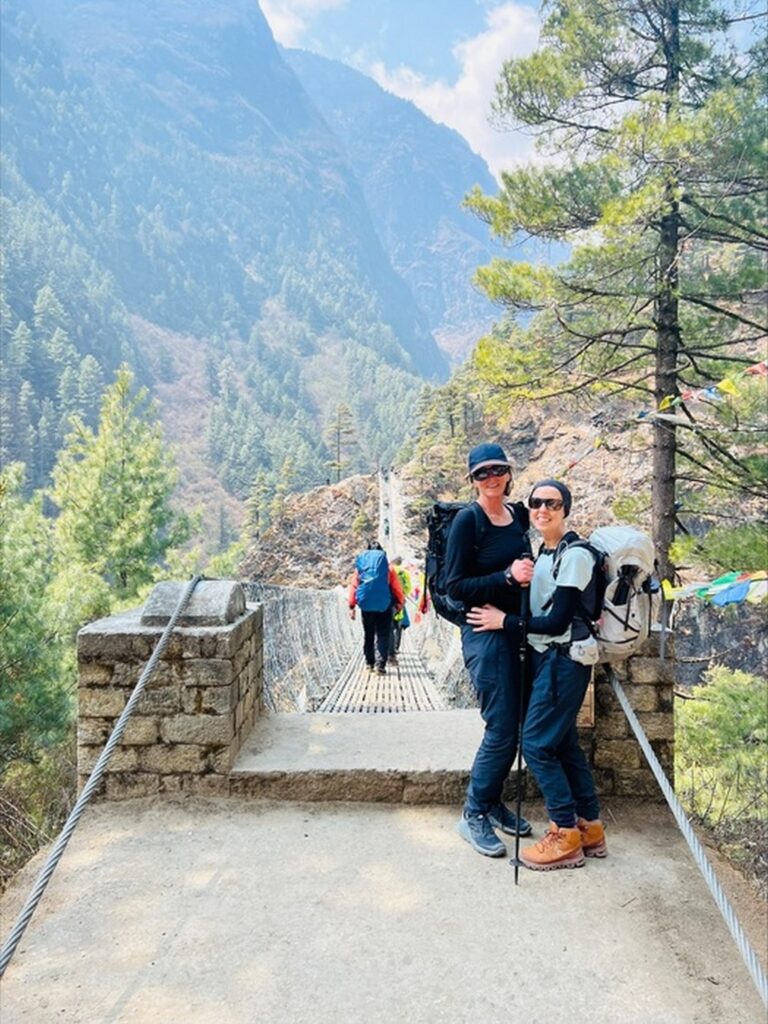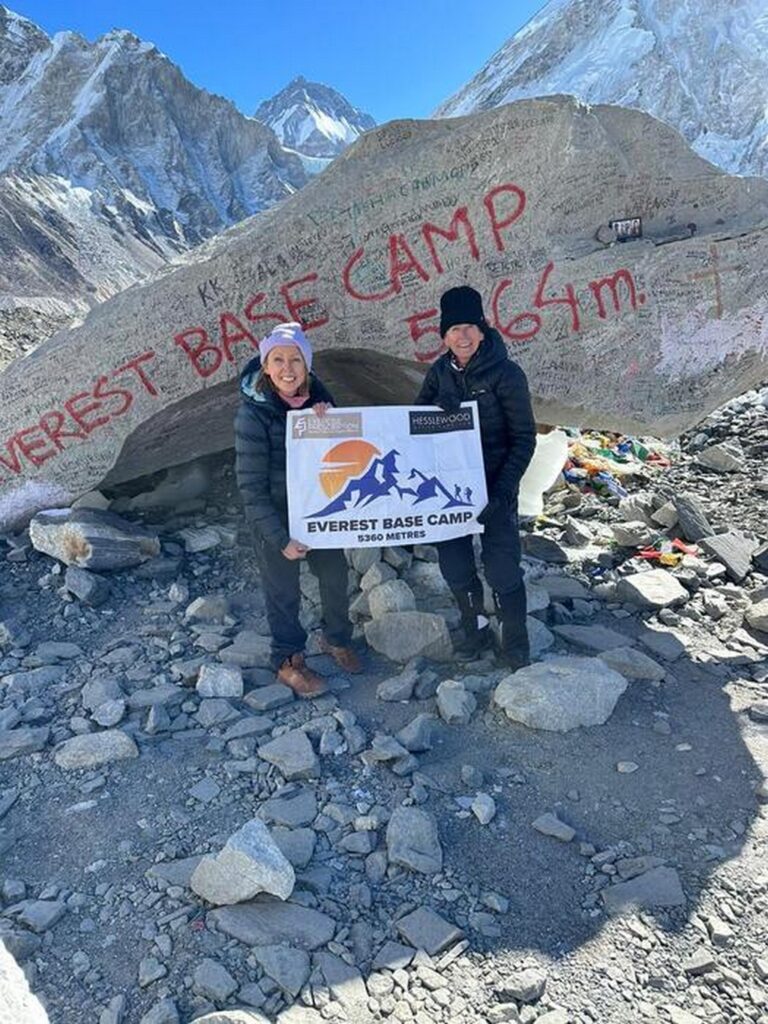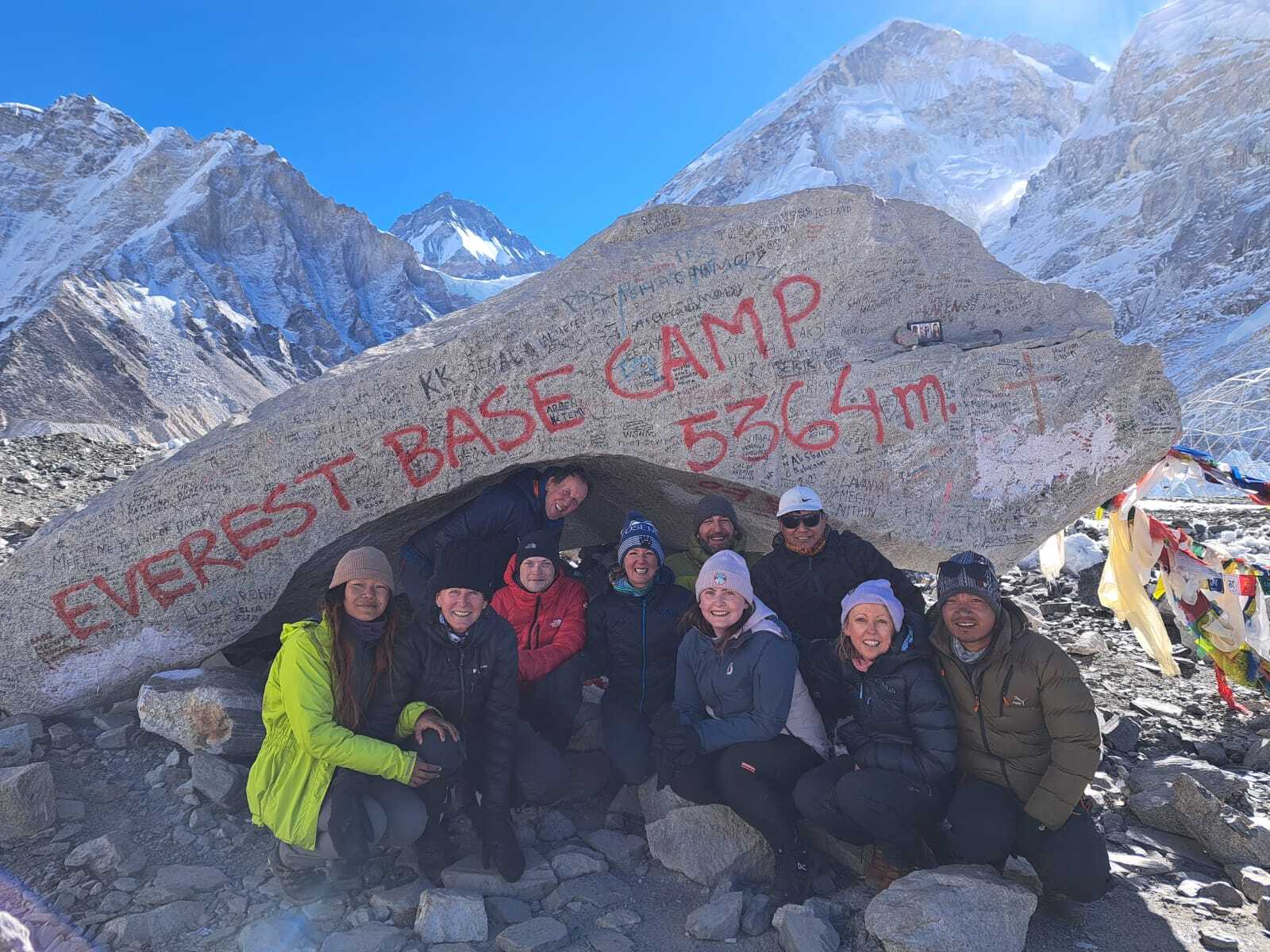Since I live near the Peak and Lake Districts, I’ve been hiking among some of the most spectacular peaks in the world. Until I participated in the Adventure Peaks 12-day Everest Base Camp Trek in March 2023 with my buddy Lorraine, Debbie, whom I personally train, and my niece Jess, I believed I had a good handle on hiking through some difficult terrain, but Debbie was new to multi-day hiking and eager to test her physical stamina and mental toughness.
Everest is a magnificent mountain that spans the border between Tibet and Nepal. Since everyone has different travel bucket list goals, I’m willing to wager that the hike to Everest Base Camp (EBC) is one that almost everyone aspires to do. Debbie was the same. She made up her mind six weeks before our journey that she was joining me on the adventure of a lifetime. I was thrilled!
About Debbie
Debbie is a 63-year-old successful businesswoman. She was in a catastrophic car accident when she was 19 and suffered severe injuries to her pelvis and left hip. Although she cannot run, she has become an expert on the cross trainer and has recently begun to enjoy road biking.
People with all fitness levels can make it to Everest Base Camp, and the Adventure Peaks team has a great track record of successful completions, but I knew Debbie would have a more enjoyable trek if she was fit for hiking and even more prepared.
Debbie began her training six weeks before our departure; she had been working out with me three to four times per week. Our sessions were typically full-body workouts that included a warmup, cardio (on the bike or cross trainer), resistance training (using body weight or dumbbells), as well as core and flexibility exercises. She had a solid foundation to build on, and her VO2 max was excellent for her age group.
The Routine of a Day at Everest Base Camp
A typical day at EBC involves about 15 km of hiking spread over 6 hours, which is not a crazy distance given that it works out to be slightly less than 3 km per hour. It was mostly uphill and on rocky terrain, which was going to make it a little more difficult on Debbie’s hips. You also need to be able to hike comfortably on back-to-back days, which is why endurance training was a key part of her programme.
While activities such as running, swimming, and cycling will all build up your cardiovascular endurance, I felt the best way to mimic trekking for Debbie was to start her on increased inclines on her cross trainer for 30 minutes. We quickly worked her way up to 60-minute sessions over a few weeks. This increased her endurance while simultaneously working on the muscles that she would be using on the trek to Everest Base Camp.

Debbie and I also used a hill known as Spout Hill near her home with headlamps on at 6 a.m. every other day with a 5kg backpack. This allowed Debbie to simulate what it was like to walk on a gradient with a weight on her back. We started with 5 climbs per session with a 5kg weight and increased it to 16 climbs and 10kg by the end of the 6 weeks.

The Trials and Tribulations
It’s important to note that the first few weeks were manageable for Debbie, and her success gave her the confidence to push herself even harder as we got closer to our departure date. It would have been inappropriate for me to start at too high an intensity for Debbie; it would not have been safe or effective.
We also did these hikes in the boots Debbie would be wearing to EBC so that she could break them in; there’s nothing worse than blisters after day 1 of your 12-day hike!
Debbie, Jess, Lorraine, and I all lugged a 35-litre daypack that weighed almost 15 kilograms. This wasn’t a heavy load, especially after witnessing a porter carrying 12 mattresses on his back! But it does make a difference when you are on the inclines.
Although the trip was completed at a steady pace, the high altitude made breathing slightly more difficult and caused us to tire out more quickly. Getting used to exercising under low oxygen conditions and training Debbie’s body to optimise its oxygen intake per breath when exerting was a great way to make the trek more pleasant for her.
While not as important as CV training, strength training focusing on the parts of Debbie’s body that will be put under stress would help make the trek more enjoyable and result in fewer aches and pains.
We continued to plan three full-body, free-weight strength training sessions per week. Free weights were going to make sure Debbie’s core and balance muscles were engaged. Exercises like squats and lunges were excellent for keeping Debbie’s lower body focused. These compound exercises were also good for her because the gradient was going to place her legs and hips under considerable strain.
Click here to see an example of one of Debbie’s workout plans
For her upper body exercises, I used bench presses, bent-over rows, bicep curls, triceps extensions, and reverse flys. Debbie’s upper body would be put to the test as she carried her backpack for a considerable distance. With all forms of strength training, it’s crucial to have perfect form. We began with a comfortable weight for 10–12 reps and then gradually increased the weight by 5–10% each week.

The Sherpa’s
Our team of sherpas were the kindest and most patient people I have ever encountered, and they fully supported our trek. They were typically highly skilled professionals who specialised in the logistics of Everest Base Camp trekking. They were very much the superheroes of our expedition. They used Yaks to carry our heavy kit bags, but they also carried extra water, food, including our daily chocolate bars (Snickers and Bounty), First Aid bags, and ensured we were efficiently fed and watered in all the teahouses. They also regularly spilt up to support our team, which had maybe broken off into smaller groups throughout the day.
Equipment
No one should skimp on the right equipment because it was crucial to the success of our expedition. Debbie had purchased all her gear before we got to Kathmandu and wore her boots on the flight to make sure they didn’t get lost in between stopovers. The last thing she wanted to do was buy new boots to hike in when she got there.
Please refer to the link to the equipment list that Adventure Peaks gave us below.
If you forget anything, you can always get it in Kathmandu, but because Debbie and I are both control freaks, we had to have everything ready before we left the UK.
Click here to visit Adventure Peaks Website
Mental Resilience
Although it is challenging to actively train for mental resilience, it is a crucial component of any endurance trek. I anticipated that there would be days that we would be cold, worn out, and sore from the previous day’s hiking, but I also anticipated that we would have to push through and muster up the strength to hike even further each day.
Anyone who knows Debbie can attest to her incredible willpower and drive, but I also knew that her regular strength and cardiovascular endurance training made her feel more confident on the mountain. She did not become tired as quickly, and because she was less stiff, she was ready to walk the following day. She overcame many obstacles and is a strong proponent of “exercise as the finest form of medicine”.

I am proud and delighted to report that on April 5, 2023, we successfully reached Everest Base Camp. I have no doubt that this incredible experience was life-changing for everyone in our group and will live with Debbie for the rest of her life.

On our trek, Debbie, Jess, Lorraine, and I were fortunate to be supported by another 5 people from the UK, including our Lead from Adventure Peaks, who shared our goals and inspired us to keep going. We received incredible moral support and had a fantastic social experience because we trekked with other people.

I have never felt such a connection to the mountains, and I spent most of my two weeks gazing up at the breath-taking views. I developed the habit of hiking close to these massive mountains, so I feel slightly more qualified to offer some advice to anyone wishing to see one of the most gorgeous mountains the world has to offer.
Useful Links:
The essential guide to trekking Everest Basecamp: the things that no one tells you
Find me on:




